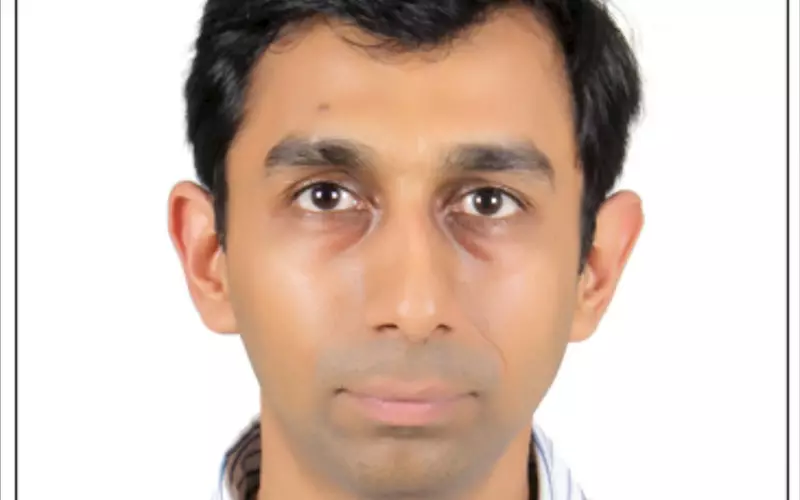Spotlight on Ashutosh Agarwal in 2000 and 2015
Ashutosh Agarwal held a job at the Quality Assurance Department of The New York Times at their Edison Printing Facility in New Jersey, USA. Ramu Ramanathan catches up with him 15 years later at Poornima Printers to find out "what's up".
26 Jun 2015 | By Ramu Ramanathan
I first heard of Ashutosh Agarwal as the quality man from The New York Times. He worked at Edison Printing Facility in New Jersey, USA. His proud father, C S Agarwal informed me that his son had graduated from the Rochester Institute of Technology’s School of Printing Management and Sciences with a Master’s in Printing Technology in the summer of 2001.
Prior to that in 1999, Ashutosh has earned a Bachelor’s degree in printing engineering from Pune University. After college, he worked with Better Communications, a digital reprographic service provider before going to RIT.
Today, he is an industry pro but he said "he got the opportunity at QA department of the New York Times through the career coordinator (for printing and packaging students) at RIT. I had focussed on colour and colour management while in RIT, and I was aware that the QA department was actively using colour management for printing the newspaper.”
Ashutosh’s father, C S Agarwal has been in the printing industry for more than fifty years and ran a press called Poornima Printers. Plus he created the PrintVision brand for the BMPA in Mumbai.
While father was making ehadways in Association work, Ashutosh was an in-plant representative of the Quality Assurance Department. His primary responsibility was to ensure that customers receive a good quality product. He said to me, “To that end, we worked hard to obtain good colour reproduction on press. To achieve that, we generate digital proofs on the newsprint we print on, and work together with pressmen to bring as close a match as we possibly can, with the proofs. We run periodic tests on our presses, and also test our RIPs and platesetters for their reproduction consistency from time to time or as and when necessary.”
Ashutosh who likes to watch movies, listen to music, read (sometimes) and experiment with cooking; rates a centre-spread ad for IBM that ran in The New York Times. This ad was very difficult to produce, in the sense that it had dark hues and heavy tint values, and care had to be taken that the ink was just enough.
That was then, this is now.
I caught up with Ashutosh in 2015.
This is what he shared with PrintWeek India.
Ramu Ramanathan (RR): Poornima Printers is primarily into commercial print? What work do you?
Ashutosh Agarwal (AA): We do advertising and marketing collaterals and a few publications. We cater to a variety of clients including media houses, retailers, branded jewellery, etc.
RR: What sort of print runs?
AA: The print run is typically between 100-1000 pieces.
RR: What type of jobs do you?
AA: The regulars being gift vouchers, invites, product booklets/catalogues, instruction manuals, etc. We like to position ourselves as ‘a print services provider’ since we do not boast of a huge manufacturing base but do take pride in the service we extend to the customers.
RR: How have you implemented your colour management knowledge in the last ten years?
AA: The colour management knowledge has been an intellectual asset. It has been most useful in approving print jobs on press (usually referring a digital colour print), and being able to effectively communicate to the printer and/or customer the limitations of WYSIWYG relevant to the job and print process, etc. The knowledge serves a strong foundation to pitch for new business as many clients are relatively new/inexperienced print buyers who want to maintain their brand colours across media but don’t quite understand how it works (rather why it doesn’t work!).
RR: Is it onerous to convince clients about colour management?
AA: Once we gain the client’s confidence in this, the ride is a lot smoother because they will be more accommodating if there are any short comings in the final result. The most important implementation has been in the planning process to flag/foresee any colour issues (typically with RGB) in customer provided print-ready files.
RR: You have had a solid stint in the USA at RIT and NY Times. The print numbers are taking a bit of beating in that corner of the world. What is the future of print according to you?
AA: From my perspective, the future is definitely digital. The print runs are shrinking by the day and deadlines getting tighter. Demands of clients are increasing and so are their expectations with what we can do with a limited budget and even lesser time lines. Digital printing has become more affordable. More and more technologies are becoming increasingly available to cater to short runs with several players in each.
RR: How so?
AA: PrintWeek India's "70 under 7 lakh" anniversary special is a testimony. That is what small print houses like ours will need to brace up to, have a raft of small equipment capable of providing multiple options to clients. The client no longer wants a simple printed piece – they are gradually converting to fine papers, and with digital printing becoming a commodity, that is becoming increasingly affordable for the end user. This not to say long runs will evaporate but that will probably evolve as a niche vertical altogether. It’s like saying printer A is a short-run specialist and Printer B is a long-run guy – and their price points will vary accordingly. Of course, the margins are better with short runs but the financial turnovers are not that great. But print will continue to grow and all technologies will flourish, digital perhaps being the leader.














 See All
See All